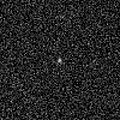Leda (moon) facts for kids
| Discovery | |
|---|---|
| Discovered by | Charles T. Kowal |
| Discovery date | September 11, 1974 |
| Orbital characteristics | |
|
Mean orbit radius
|
11,160,000 km |
| Eccentricity | 0.16 |
| 240.92 d (0.654 a) | |
|
Average orbital speed
|
3.4 km/s |
| Inclination | 27.46° (to the ecliptic) 29.01° (to Jupiter's equator) |
| Satellite of | Jupiter |
| Physical characteristics | |
|
Mean radius
|
10 km |
| ~1250 km² | |
| Volume | ~4200 km³ |
| Mass | 1.1×1016 kg |
|
Mean density
|
2.6 g/cm³ (assumed) |
| ~0.0073 m/s2 (0.001 g) | |
| ~0.012 km/s | |
| Albedo | 0.04 (assumed) |
| Temperature | ~124 K |
| 20.2 | |
Leda, also known as Jupiter XIII, is one of the many moons orbiting the giant planet Jupiter. It's not perfectly round like Earth's Moon, and it moves in a "prograde" direction. This means it orbits Jupiter in the same direction that Jupiter spins.
Leda was discovered by an astronomer named Charles T. Kowal. He found it at the Palomar Observatory in California on September 14, 1974. He spotted it on photos taken over three nights, from September 11 to 13. The moon was later named after Leda, a character from ancient Greek myths. She was a lover of Zeus, who is the Greek version of the Roman god Jupiter.
Leda's Family: The Himalia Group
Leda is part of a group of moons called the Himalia group. This group includes five moons that orbit Jupiter at a similar distance. They are found between 11 million and 13 million kilometers away from Jupiter.
These moons also have a similar tilt in their orbits, about 27.5 degrees. This means their paths around Jupiter are not flat like a pancake. The way these moons orbit can change over time. This is because of the strong pull of gravity from both the Sun and Jupiter itself.
Images for kids
See also
 In Spanish: Leda (satélite) para niños
In Spanish: Leda (satélite) para niños


